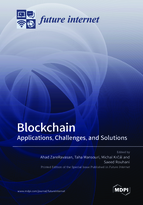Blockchain: Applications, Challenges, and Solutions
A special issue of Future Internet (ISSN 1999-5903). This special issue belongs to the section "Internet of Things".
Deadline for manuscript submissions: closed (31 March 2022) | Viewed by 46648
Special Issue Editors
Interests: information systems; blockchain; business analytics; big data; cryptocurrencies
Interests: machine learning; deep learning; computer vision; complex systems modelling; explainable AI
Special Issues, Collections and Topics in MDPI journals
Interests: information systems; blockchain; knowledge management; business process management
Special Issue Information
Dear Colleagues,
Blockchain is perceived as one of the most promising technologies, with a projected annual global spending of around US$9.7 billion by 2021. Blockchain is a distributed append-only time-stamped data structure which allows us to have a distributed peer-to-peer network where non-trusting members can verifiably interact with each other without the need for a trusted authority. Blockchain, through smart contracts, enhances transparency and trust and enables new ways of creating disrupted business models. Nevertheless, recent attention on Blockchain has merely focused on its applications in the financial sector. However, the impact of Blockchain technology goes beyond the financial industry.
Recently, there has been an increasing interest in the combination of Blockchain with other emerging and state-of-the-art technologies (such as artificial intelligence, big data analytics, and the Internet of Things) to create business value. Despite these growing interests in Blockchain business applications, there are dozens of challenges for Blockchain’s wide adoption. These challenges are around scalability, interoperability, standards, privacy, security, governance, and consensus mechanisms that need to be addressed.
This Special Issue seeks original, unpublished papers presenting theoretical and applicative proposals in all Blockchain research areas, focusing more on Blockchain applications and challenges. Authors are encouraged to submit articles that include existing problems/challenges and suggestions of how they could be resolved and cover its revolutionary prospects and their applications and implications for real-life practices. Review/survey/technical papers are encouraged. Topic areas include, but are not limited to the following:
- Blockchain as a disruptive technology to disrupt business models;
- Blockchain Applications in real life (e.g., finance, supply change, healthcare, logistics, smart cities, advertising, social networking);
- Exploiting the advantages of Blockchain and challenges to be addressed;
- Blockchain ecosystem and the roles of key players (e.g., government, regulatory, startups, freelancers, investors, miners, and mining pools);
- Successes and failures of emerging Blockchain initiatives;
- Blockchain integration with other technologies (e.g., artificial intelligence, big data analytics, and the Internet of things, 5G, edge/fog/cloud technologies);
- Blockchain architectures, protocols, algorithms, and consensus mechanisms;
- Blockchain startups and how they are revolutionizing Blockchain applications.
Dr. Ahad ZareRavasan
Dr. Taha Mansouri
Dr. Michal Krčál
Dr. Saeed Rouhani
Guest Editors
Manuscript Submission Information
Manuscripts should be submitted online at www.mdpi.com by registering and logging in to this website. Once you are registered, click here to go to the submission form. Manuscripts can be submitted until the deadline. All submissions that pass pre-check are peer-reviewed. Accepted papers will be published continuously in the journal (as soon as accepted) and will be listed together on the special issue website. Research articles, review articles as well as short communications are invited. For planned papers, a title and short abstract (about 100 words) can be sent to the Editorial Office for announcement on this website.
Submitted manuscripts should not have been published previously, nor be under consideration for publication elsewhere (except conference proceedings papers). All manuscripts are thoroughly refereed through a single-blind peer-review process. A guide for authors and other relevant information for submission of manuscripts is available on the Instructions for Authors page. Future Internet is an international peer-reviewed open access monthly journal published by MDPI.
Please visit the Instructions for Authors page before submitting a manuscript. The Article Processing Charge (APC) for publication in this open access journal is 1600 CHF (Swiss Francs). Submitted papers should be well formatted and use good English. Authors may use MDPI's English editing service prior to publication or during author revisions.
Keywords
- Blockchain
- Crypto Currencies
- Blockchain applications
- Blockchain challenges
- Distributed ledger technologies
- Blockchain and Internet of Things
- Blockchain and big data
- Blockchain regulation
- Smart contracts
- Blockchain architectures.









